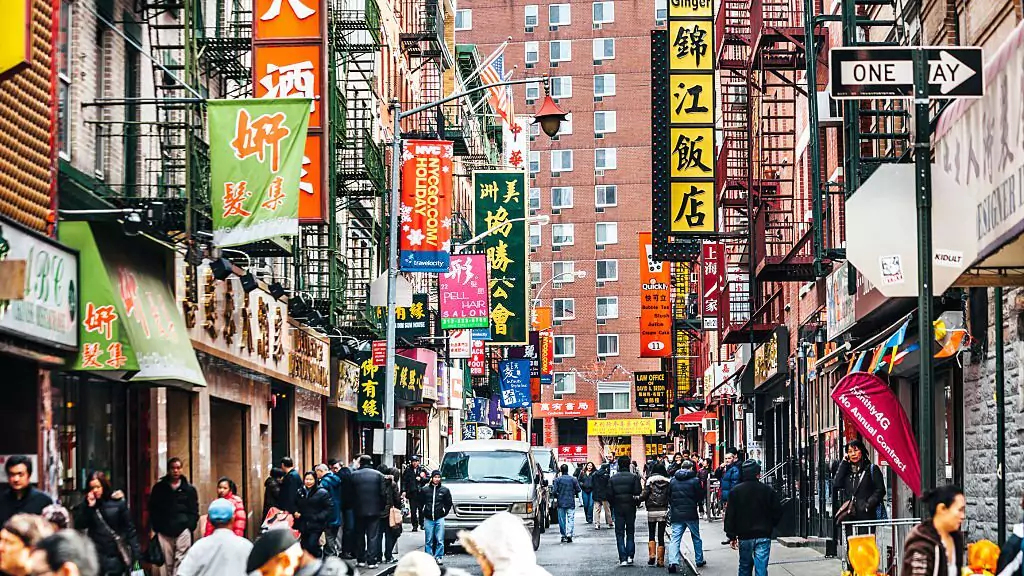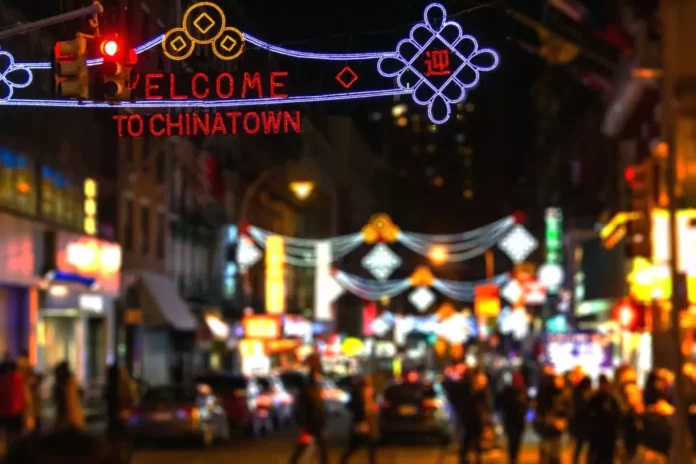Introduction
Chinatown New York is a vibrant and bustling neighborhood located in Lower Manhattan. It is home to one of the largest Chinese populations outside of Asia and is a hub of cultural activity and culinary delights. Exploring the rich history and culture of Chinatown is not only a fascinating experience, but also an important way to appreciate the contributions of the Chinese community to the city of New York.

The Origins of Chinatown New York: A Historical Perspective
The history of Chinatown in New York City dates back to the mid-19th century when Chinese immigrants began arriving in the United States in search of better opportunities. Many of these early immigrants came from the Guangdong province in southern China and settled in the area that is now known as Chinatown. They faced discrimination and prejudice, but they persevered and established a thriving community.
The establishment of Chinatown in New York City was not without its challenges. The Chinese Exclusion Act of 1882, which prohibited Chinese laborers from entering the United States, had a significant impact on the community. However, despite these obstacles, Chinatown continued to grow and flourish, becoming a center for Chinese culture and commerce.
The Cultural Significance of Chinatown New York: A Deep Dive
Chinatown plays a vital role in preserving Chinese culture and traditions in New York City. The neighborhood is home to numerous cultural institutions, including museums, art galleries, and community centers, that showcase the rich heritage of the Chinese community. These institutions not only educate visitors about Chinese history and traditions but also provide a space for the community to come together and celebrate their culture.

Chinese culture has also had a profound influence on the art, music, and literature of Chinatown. The neighborhood is known for its vibrant street art, traditional Chinese music performances, and literary events that highlight the works of Chinese-American authors. These artistic expressions serve as a bridge between the past and the present, allowing the community to share their stories and experiences with a wider audience.
Community organizations in Chinatown play a crucial role in promoting cultural awareness and understanding. These organizations organize events and activities that bring the community together, such as festivals, parades, and workshops. They also provide resources and support for new immigrants, helping them navigate the challenges of living in a new country while preserving their cultural identity.
The Architecture of Chinatown New York: A Visual Tour
The architecture of Chinatown New York is a unique blend of Chinese and Western influences. The neighborhood is characterized by its narrow streets, tenement buildings, and traditional Chinese architectural elements such as pagoda roofs and ornate facades. These architectural features give Chinatown its distinct character and make it a visually captivating place to explore.
Certain landmarks and buildings in Chinatown hold significant cultural and historical importance. For example, the Mahayana Buddhist Temple is one of the oldest Buddhist temples in the United States and serves as a spiritual center for the community. The Confucius Plaza, with its iconic red gate, is a symbol of Chinatown’s cultural heritage and serves as a gathering place for residents and visitors alike.
The Food Scene in Chinatown New York: A Culinary Adventure
One of the highlights of visiting Chinatown New York is the incredible food scene. The neighborhood is home to a diverse range of Chinese cuisine, from Cantonese dim sum to Sichuan hot pot. Exploring the food options in Chinatown is like embarking on a culinary adventure, with each restaurant offering its own unique flavors and specialties.
Certain dishes in Chinatown have a rich history and cultural significance. For example, the Peking duck, a famous dish from Beijing, is a must-try when visiting Chinatown. This dish has a long tradition in Chinese cuisine and is known for its crispy skin and succulent meat. Other popular dishes include dumplings, noodles, and various types of seafood.
When visiting Chinatown, it is recommended to try some of the local restaurants and street food vendors. Some popular establishments include Jing Fong, a dim sum restaurant known for its bustling atmosphere and wide variety of dumplings, and Wo Hop, a late-night eatery famous for its Cantonese-style dishes. Exploring the food scene in Chinatown is a delicious way to experience the neighborhood’s culture and traditions.
The Festivals and Celebrations of Chinatown New York: A Vibrant Experience
Chinatown New York is known for its vibrant festivals and celebrations, which provide a unique opportunity to experience the neighborhood’s culture and traditions. One of the most famous events is the Lunar New Year Parade, which takes place in February and features colorful floats, lion dances, and firecrackers. This celebration marks the beginning of the lunar calendar and is a time for families to come together and honor their ancestors.
Other festivals and celebrations held in Chinatown throughout the year include the Dragon Boat Festival, the Mid-Autumn Festival, and the Mooncake Festival. These events showcase traditional Chinese customs and rituals, such as dragon boat races, lantern displays, and mooncake tastings. Attending these festivals is a vibrant and immersive experience that allows visitors to fully appreciate the cultural heritage of Chinatown.
The Role of Chinatown New York in the City’s Economy: A Business Perspective
Chinatown plays a significant role in the local economy of New York City. The neighborhood is home to a wide range of small businesses, including restaurants, grocery stores, and retail shops. These businesses not only provide employment opportunities for the local community but also contribute to the city’s tax revenue.
Small businesses in Chinatown face unique challenges, including rising rents and competition from larger corporations. However, they also have a strong sense of community and support from local residents. Many businesses in Chinatown have been passed down through generations, creating a sense of continuity and tradition.
The Challenges Faced by Chinatown New York: A Community Perspective
Chinatown New York faces several challenges that threaten its cultural heritage and sense of community. One of the biggest challenges is gentrification, which has led to rising rents and the displacement of long-time residents and businesses. As the neighborhood becomes more desirable, there is a risk of losing the unique character and cultural traditions that make Chinatown special.
Preserving cultural traditions in a rapidly changing city is another challenge faced by Chinatown. As younger generations assimilate into American culture, there is a risk of losing the language, customs, and traditions that have been passed down through generations. Community organizations and cultural institutions play a crucial role in addressing these challenges by providing resources and support for the community.
The Future of Chinatown New York: A Look Ahead
Despite the challenges it faces, Chinatown New York has a bright future ahead. The neighborhood has the potential for growth and development, while still preserving its unique character and cultural heritage. It is important for the community to continue advocating for affordable housing, cultural preservation, and economic opportunities.
Community organizations will play a crucial role in shaping the future of Chinatown. These organizations can work together to address the challenges faced by the neighborhood and ensure that it remains a vibrant and thriving community. By supporting local businesses, attending cultural events, and engaging with the community, visitors can contribute to the future success of Chinatown.
Exploring Chinatown New York: A Guide for Visitors
When visiting Chinatown New York, there are several recommendations to make the most of your experience. Start by exploring the narrow streets and alleys, where you will find hidden gems such as traditional herbal medicine shops, tea houses, and street food vendors. Be sure to visit some of the cultural institutions, such as the Museum of Chinese in America, to learn more about the history and heritage of the Chinese community.
Navigating Chinatown can be a bit overwhelming, especially for first-time visitors. It is recommended to use a map or a guidebook to help you find your way around. The neighborhood is easily accessible by public transportation, with several subway lines and bus routes serving the area.
There are also several must-see attractions and experiences in Chinatown. Take a stroll through Columbus Park, a popular gathering place for residents and visitors alike. Visit the Chinatown Ice Cream Factory for a taste of unique flavors such as lychee, red bean, and black sesame. And don’t forget to explore the local markets, where you can find fresh produce, exotic ingredients, and traditional Chinese goods.
Conclusion
Exploring the rich history and culture of Chinatown New York is not only a fascinating experience but also an important way to appreciate the contributions of the Chinese community to the city of New York. From its origins as a haven for Chinese immigrants to its vibrant festivals and culinary delights, Chinatown offers a unique and immersive experience for visitors.
By supporting local businesses, attending cultural events, and engaging with the community, visitors can contribute to the preservation and growth of Chinatown. Whether you are interested in history, art, food, or simply immersing yourself in a different culture, Chinatown New York has something to offer everyone. So next time you find yourself in New York City, be sure to take the time to explore this vibrant and dynamic neighborhood.


